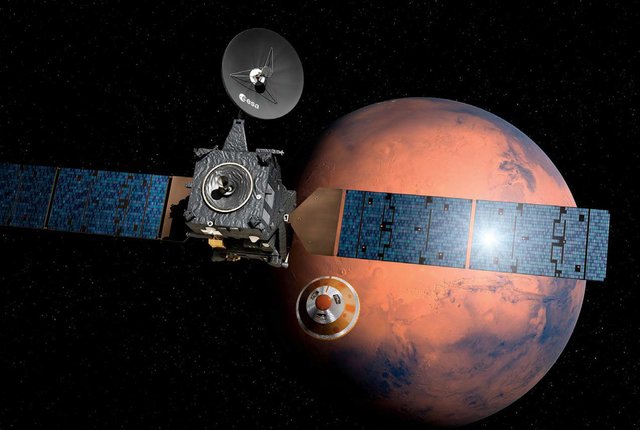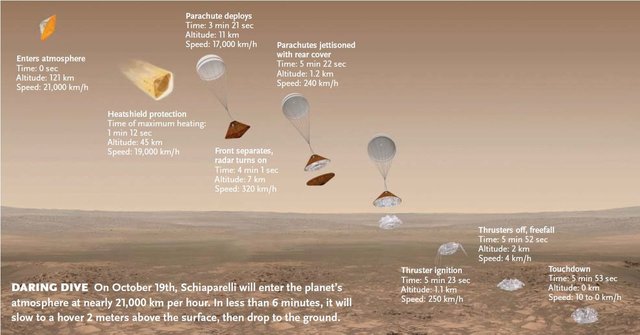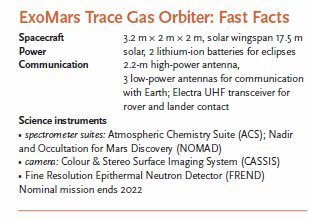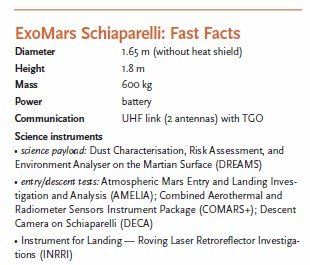Looking for Life on Mars: The first phase of the ExoMars mission arrives at the Red Planet in October to search for evidence of past or present life.
We obsess over Mars. Since the dawn of the Space Age, scientists have sent (or tried to send) more than 40 spacecraft to the Red Planet. Half have failed. In fact, only NASA has managed to land anything that operated on the surface for more than 2 minutes.
The European and Russian space agencies are hoping to change that. Their ExoMars mission is about one thing: life. The goal is to examine Mars for evidence of exobiology, or life beyond Earth — hence the mission’s name. It will also be sensitive to signs of active geology.

ExoMars has two phases. The first involves an orbiter-lander combo that arrives at the Red Planet in mid-October; the second will be a full-fl edged rover that launches a few years from now. When phase one arrives, the lander, named Schiaparelli, will detach and plunge to the surface. Meanwhile, the main spacecraft, called the Trace Gas Orbiter (TGO), will be captured by the planet’s gravity and, over the next year, settle into a circular, near polar orbit 400 kilometers (250 miles) above the surface, flying just above NASA’s Mars Reconnaissance Orbiter.
Just a Whiff
Once it begins science operations in December 2017, TGO will search for signs of life by studying changes in the atmosphere and on the surface. It’s designed to detect and characterize trace gases, which are any compound that makes up less than 1% by volume of Mars’s atmosphere — everything besides carbon dioxide (an overwhelming 96%), argon, and nitrogen. This most wanted list includes water vapor and methane (CH4).
Scientists now know that methane exists on Mars, and they’ve seen hints of a seasonal cycle in its levels. But methane is a pretty pickle of a find, because unless it’s replenished it should only survive in the planet’s atmosphere for about 400 years before being broken down by sunlight. On Earth, most methane comes from microbes called methanogens, raising the hope that Earth’s smaller sibling might host alien life. But methane can also come from geological processes, such as the reaction of hot water and the mineral olivine (called serpentinization) or from sunlight’s ultraviolet rays breaking up micrometeoroid dust deposited on the surface.
Disentangling where the methane and other trace gases come from will be no easy task. Isotopic ratios will matter — how much carbon-13 versus carbon-12 methane contains could favor either a biotic or abiotic source, for example. Yet researchers care not so much about each trace compound on its own but rather how it changes with respect to others, and how these abundances vary (or don’t) with location, season, and local time. Sulfur dioxide (SO2), for example, might indicate a geologically recent volcanic eruption, but that depends on what other simultaneous changes the orbiter detects.
After TGO has established a broad picture of what’s in the atmosphere, it will home in on the details, such as the ratio of hydrogen to deuterium (“heavy hydrogen”). It will also characterize the whole atmosphere, specifically its pressure and temperature, as well as levels of aerosols, water vapor, ozone (O3), and other compounds, then figure out the circulation patterns to track these things back to their sources.
A Spectrometric Mission
To achieve these goals, the orbiter carries a camera, two spectrometer packages, and a neutron detector.
With the camera, the mission team will create stereo surface maps and look for changes that correlate with any variations detected in the atmosphere.
The spectrometer suites will exploit sunlight to study Mars. As TGO loops around the planet, the spacecraft will study sunlight as it reflects off the surface, scatters in the air above the horizon, and passes through the atmosphere to the craft when it’s flying through Mars’s shadow. TGO will circle Mars every 2 hours, so it will be eclipsed by the planet 12 times a day (with a few exceptions due to the spacecraft’s migrating orbit). During these frequent occultations, the spacecraft will depend on two lithium-ion batteries instead of its solar panels, which wingtip-to-wingtip span 17.5 meters (57.4 feet), or nearly the length of a bowling lane.
The fourth instrument, the neutron detector, will determine how much water ice exists within the top meter of the planet’s surface. This detection will be an indirect one. When cosmic rays slam into the surface, they free neutrons from the atoms there. These neutrons scatter every which way, like the splat of a paint-gun pellet. Some of them even make it all the way to space, where TGO will catch them. The distribution of their velocities reveals how much hydrogen comprises the material they passed through. Since most hydrogen will be in water molecules, scientists (fairly safely) assume that any hydrogen they detect is a proxy for water.
Water ice is a big deal for long-term Mars exploration. Its abundance will influence future landing-site selections, both robotic and crewed. For instance, those working on NASA’s Journey to Mars initiative — which aims to launch the first crewed mission to the Red Planet in 2035 — are currently exploring strategies for extracting water ice and other resources from the rust-stained Martian soil.
Touchdown
The second part of ExoMars 2016 is Schiaparelli. It’s a lander, not a rover — it’s just going to sit there. But it is a technology testbed for the upcoming rover.
Schiaparelli will separate from TGO on October 16th. Three days later, it will enter the upper atmosphere in a daredevil dive of nearly 21,000 km/h (13,000 mph). As it plummets, the fl ying-saucer-like lander will measure the atmosphere’s density, pressure, and temperature. Engineers will also use the dive to test the heat-shield design.

In less than 6 minutes, Schiaparelli will fall about 120 km and, thanks to aerobraking, a 12-meter-wide parachute, and three clusters of hydrazine thrusters, will slow to a standstill hover 2 meters above the surface. Then the thrusters will cut and drop it to the ground. A crushable bottom, similar to a car’s crumple zone, will absorb the thud.
Once on the surface, Schiaparelli will operate on battery power for 2 to 8 Martian days, or sols, which are 24.7 hours long. It will monitor local weather conditions, including humidity, dust, and wind speed, as well as electric fields near the surface, which might help maintain or even increase the atmosphere’s dust levels (scientists don’t yet know, because they’ve never measured these surface fields).
Airborne dust could pose a problem. Due to orbital mechanics, the lander arrives in the middle of the planet’s storm season. Plus, its landing site in Meridiani Planum — roughly 50 km from where NASA’s Opportunity rover is exploring the crater Endeavour — lies close to a track frequented by dust-laden winds. But storms usually occur in two peak periods, and Schiaparelli should arrive after the first peak. Regardless, engineers have designed it to handle blustery conditions.
All this is merely ExoMars’s first act; next comes the rover. Originally scheduled for a 2018 launch, the rover has been delayed to 2020. When it does reach the Red Planet, it will drill into the surface and collect samples, both to conduct exobiological and geochemical research and as a test for an upcoming international sample-return mission.
ExoMars won’t be the only project heading to the Red Planet that year. NASA’s Mars 2020 rover will also cache samples and look for hints of past life. In addition, it will test technology to extract oxygen from the atmosphere’s carbon dioxide, in preparation for human exploration.


Mars is an incredibly fascinating and awe-inspiring place. Just check out the latest imagery from the Mars Rover. I mean, these are super hi-res and clear - you'd swear they were taken in the Arizona desert! ;-) (I'm not actually implying they are - but some actually believe that silliness.)
Anyway - I'm sure I'm not alone when I say I can't wait for the first humans to walk (and apparently live there) - since the first human contact is supposed to be a one-way trip! That said, I hate to be cynical - but who in their right mind would want to live in a completely uninhabitable desert that spans for millions of square km's? Well - apparently there are thousands. Yet, what's harder to believe is that it's all supposed to be happening in the next TEN years? I'll believe it when I see it. Some are saying it's just a scam at this point. I'm not sure I'd go that far... but... who knows?
http://www.mars-one.com/